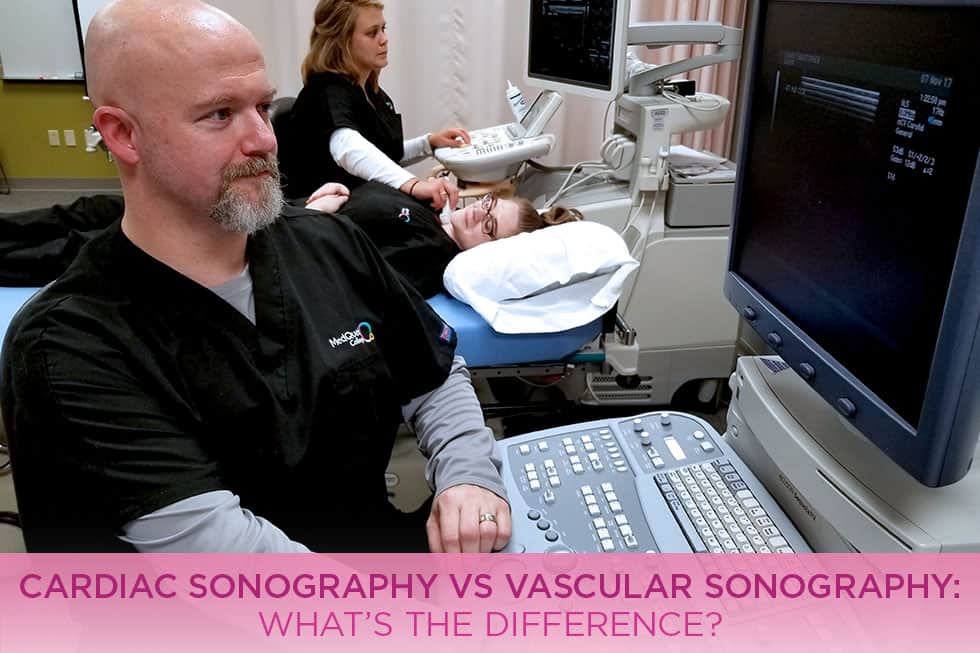If you’ve been contemplating a career that involves helping people from the inside out, a career in the sonography field could be right for you. You should know that there are several areas within the field of sonography you can choose to specialize in. Two of those specialty areas are Cardiac Sonography and Vascular Sonography. But before we dive into the differences between Cardiac and Vascular Sonography, let’s explore what sonography is in general.
What is Sonography?
Also referred to as ultrasound technology, sonography is an imaging process that uses high-frequency sound waves to generate images of structures inside the body. This type of imaging provides doctors, surgeons, and other medical professionals with invaluable diagnostic information. It is a critical tool for diagnosing and treating various diseases and conditions effectively.
There are several areas of specialization within the sonography field, such as obstetrics, gynecology, pediatric sonography, and more. In the case of Cardiac and Vascular Sonography, these two areas in ultrasound technology deal with the circulatory system, but their focus is on entirely different specialties.
The Differences Between Cardiac Sonographers and Vascular Sonographers
Cardiac Sonographers and Vascular Sonographers both play an important role in diagnostic imaging, and both use specialized equipment to produce images of the body. However, they work in different areas of the body’s circulatory system.
Cardiac Sonographers primarily focus on the heart and its function. They use ultrasound technology to produce images of the heart’s chambers, valves, and blood vessels to evaluate its structure and function. Cardiac Sonographers typically work in hospitals, clinics, or diagnostic imaging centers.
On the other hand, Vascular Sonographers specialize in imaging the body’s blood vessels, including arteries and veins. They use ultrasound technology to evaluate the blood flow through these vessels, looking for any signs of blockages or abnormalities. Vascular Sonographers often work in vascular labs or radiology departments.
Typical Duties of Cardiac Sonographers
Cardiac Sonographers, also known as echocardiographers, use ultrasound technology to capture images of the heart and its chambers, valves, and blood vessels. They work in hospitals, clinics, and private practices to assist cardiologists and physicians in diagnosing and treating heart-related conditions. Cardiac Sonographers collaborate with other healthcare professionals, including cardiologists, physicians, and nurses, and typically perform the following duties regularly:
- Perform echocardiograms
- Produce real-time images of cardiac structures to assist doctors in diagnosing cardiovascular disease
- Evaluate cardiac abnormalities and associated complications
- Track and assess chronic heart conditions
- Identify and evaluate narrowed or leaking heart valves
- Determine the causes of heart murmurs, chest pain, or shortness of breath
What are the Typical Duties of a Vascular Sonographer?
Vascular Sonographers primarily focus on the blood vessels and arteries in the circulatory system, but they may also work on veins and the lymphatic system. The regular duties of a Vascular Sonographer typically include the following:
- Monitoring blood flow
- Identifying blockages
- Locating blood clots, tumors, aneurysms, and other blood vessel abnormalities
- Determining if angioplasty is a viable treatment option
Just like Cardiac Sonographers, you’ll also be collaborating with physicians and other medical professionals. And since both roles involve face-to-face time with patients, excellent communication skills are essential. You’ll find both Cardiac and Vascular Sonographers working in a variety of medical facilities, such as:
- Physician offices
- Diagnostic labs
- Hospitals
- Outpatient clinics
- Mobile ultrasound businesses
Training Requirements for Cardiac and Vascular Sonographers
To become a Cardiac or Vascular Sonographer, you must complete an accredited two-year associate degree or diploma program in sonography. These programs usually include anatomy, physiology, patient care, medical terminology, and ultrasound physics courses. However, you’ll also receive specialized training in cardiac or vascular imaging based on which path you decide to take and hands-on training in most programs. After completing the program, the next step is to obtain certification by passing a national examination through CCI (Cardiovascular Credentialing International). Upon passing the exam, you’ll receive the Registered Cardiac Sonographer (RCS) or Registered Vascular Specialist (RVS) certification. Additionally, students are eligible to obtain certification by passing the examination administered by ARDMS (American Registry for Diagnostic Medical Sonography). This certification exam must be taken immediately upon completion of the sonography program.
Career Outlook for Cardiac Sonographers and Vascular Sonographers
According to the Bureau of Labor Statistics (BLS), the employment of Diagnostic Medical Sonographers (including both Cardiac and Vascular Sonographers) projects a 15% percent growth from 2021 to 2031, which is much faster than the average for most occupations. The median annual wage for cardiac and vascular sonographers in 2021 was $60,570.
With a strong job outlook for the foreseeable future and earning potential, pursuing a Cardiac or Vascular Sonography career could be a great option if you’re looking for a profession in healthcare. If you’re ready to possibly earn a living in this industry, check out the associate degree program in Diagnostic Medical Sonography at MedQuest College. With lifetime career placement services and hands-on experience through an externship in a real-world medical setting, MedQuest is helping students get the training and skills they need to launch careers as Cardiac or Vascular sonographers. Contact us today to learn more or to schedule a campus tour.

